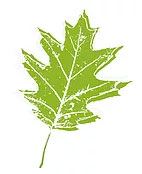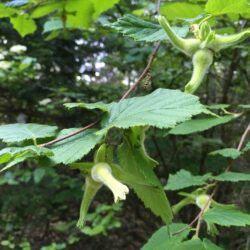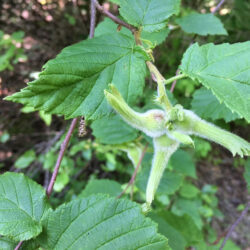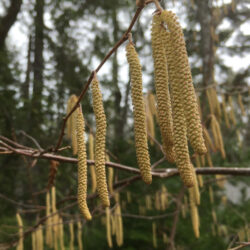Etymology
Beaked hazelnut gets its specific epithet (cornuta) from the Latin word for horn, referring to the horny projection on the beaked fruit. The genus name comes from the Greek word korylos or korys, meaning a helmet, in regard to the husk on the nut.
Native Habitat
Edges of forests, fields, and wetlands; forest understory. It is common in Maine. Its native habitat ranges from British Columbia to Quebec south to Illinois and Georgia (with a variety occurring from British Columbia to California).
Garden Uses
This dense, suckering shrub is ideal for naturalized areas or as a hedge, thicket, or barrier. Its tenacious root system makes it highly effective for stabilizing soil on slopes or banks.
Overview
Hazelnut shrubs are highly beneficial to wildlife, offering food and shelter for birds, insects, and small mammals. Beaked hazelnuts are adaptable to a range of soil types and moisture levels, though they thrive in rich, well-drained soils. They do well in both full sun and partial shade. When fully grown, they can reach a height of 15 feet, though 4 to 12 feet is more common in Maine. The upward-growing branches create a rounded, vase-like shape with multiple stems, and their strong root system is excellent for soil stabilization. It strongly resembles the related American Hazelnut (Corylus americana), which has glandular hairs on twigs, leaf stalks and husks, and the husks lack the long beak. The two species' ranges overlap and may be found growing side by side, but beaked hazelnut is more common in moist sites and American Hazelnut in drier sites.
Spread
The above-ground spread of beaked hazelnut can range from 4 to 6 feet. It has a shallow, dense, and extensive underground root system, consisting of a taproot and interconnected lateral roots and rhizomes. More than 90% of the roots and rhizomes are concentrated within the top 6 inches of soil. In a Minnesota-based study, the majority of beaked hazelnut rhizomes grew in the bottom of the organic soil layer, lying at or close to mineral soil. The taproot of beaked hazelnut typically extends more than 2 feet below the soil surface.
Leaves and Stems
Up to 4-inch long oval to nearly round leaves have doubly serrated margins and rounded or heart-shaped bases. They are bright green and usually hairy along the veins. The leaves turn a soft yellow in the fall. The twigs are light brown.
Flowers
Each plant has both male and female flowers. Flowering in early spring, the female flower is a tiny, spidery burst of magenta, usually at the end of the branches. The yellowish drooping catkins of the male flower also add winter interest to the landscape even before plants have leafed out. Since hazelnuts have separate male and female flowers and there are no leaves this early in the season to impede the wind’s capacity to assist with pollination, the pollen grains are readily transported to the female flowers.
Fruit/Seed
The hard nut is enclosed in a husk with a tubular protuberance like a strange nostrum or beak.
Wildlife Associates
The nuts of beaked hazelnut are edible and provide an important food source for birds, squirrels, hares, and many other animals. The dense coverage created by this thicket-forming shrub provides valuable wildlife shelter. During the growing season, hazelnuts provide food for many beneficial insects, including some of the giant silkworm moths of Maine, like Cecropia and Polyphemus moths. In Douglas Tallamy’s “Bringing Nature Home,” he notes that over 130 species of moths and butterflies may use hazelnuts as their caterpillar food source. Many birds depend on caterpillars specifically as protein for their offspring. The early blooming catkins provide pollen to native bees.
Propagation
Due to limited seed production and wildlife competition, collecting enough seeds from natural sites can be difficult, so vegetative propagation through layering or division is often a more reliable method. Hazelnuts have a strong habit of forming root suckers, which can be helpful for propagating a particular seedling with desirable traits. Suckers are vertical sprouts that grow from shallow lateral roots, typically less than 3 inches deep. By exposing the root and cutting it between the trunk and the sucker, you can create a new plant that is a clone of the original. While root suckers initially lack fine roots (other than the single root they originate from), fine roots generally begin to develop once the sucker is replanted. Will Bonsall recommends trimming at least one-third of the shoot to promote rootlet growth and to balance the reduced root system with the above-ground shoot. Since hazelnuts, like most nuts, do not produce true-to-seed offspring, it’s not possible to reliably capture desired traits by planting nuts. If you choose to propagate from seed, the nuts should pass the float test—any that float are empty and should be discarded. For the best results, seeds should be sown immediately after harvesting in a cold frame. If stored, seeds require 3 to 6 months of cold stratification. Pre-soaking the seeds in warm water for 48 hours and allowing a two-week warm period before cold stratification can be beneficial. It's important to protect the sown seeds from rodents.
Ethnobotanical Uses
Beaked hazelnuts are smaller than their European counterparts, the type typically found in grocery stores, but they are just as tasty. These high-protein, sought-after nuts are delicious, though there’s some effort involved in harvesting them. First, you must remove the outer covering, which is protected by short hairs. Next, you’ll need to crack open the hard shell with a nutcracker. And, of course, you'll need to be quick, as local wildlife often beats you to them! Native Americans used the nuts for food, the wood for arrows and other items and the shoots were twisted into rope. It was also used medicinally.
Garden Location
West Woods (see garden map)
Anecdotal Information
The American hazelnut is most commonly found in the nursery trade, although the beaked hazelnut is most commonly found growing wild in Maine. At NGBH, there are several old shrubs growing in almost complete shade. They do not seem to flower or fruit well in these conditions, but they are persisting.
Sources
Coastal Rivers Conservation Trust
Maine Organic Farmers and Gardeners Association
Native Plants Pacific Northwest
North Carolina Extension Gardener Plant Toolbox
USDA Fire Effects Information System (FEIS)
Plant Profile by Rachel Emus



